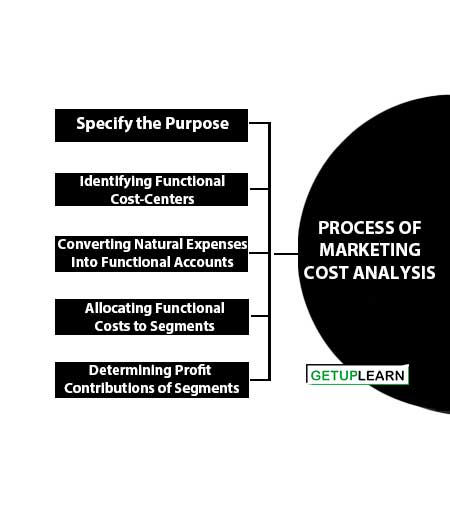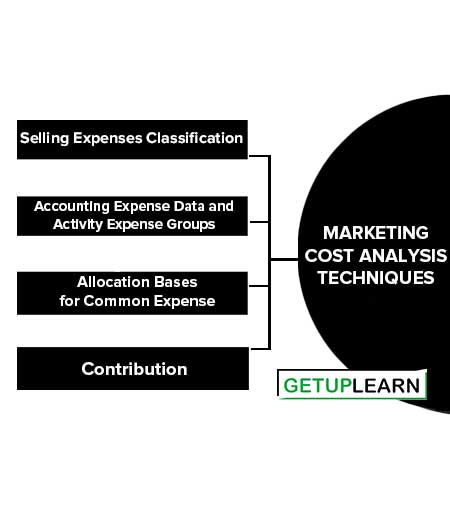Table of Contents
What is Marketing Cost Analysis?
In the Marketing cost analysis; the sales volume and the selling expenses are analyzed to determine the relative profitability of particular aspects of sales operations within a specified period of time.
The first step in marketing cost analysis is sales analysis by territories, sales personnel, products, class of account, size of order, marketing channels, and other categories.
The outcome indicates the relative profitability of the sales territories. Marketing cost analysis searches for ways to improve profit performance by exposing the relative strengths and weaknesses of the sales organization and its salespeople.
Process of Marketing Cost Analysis
These are the stages of the process of marketing cost analysis:
- Specify the Purpose
- Identifying Functional Cost-Centers
- Converting Natural Expenses Into Functional Accounts
- Allocating Functional Costs to Segments
- Determining Profit Contributions of Segments

Specify the Purpose
The sales managers must decide the purpose to determine the profitability of sales territories, sales representatives, customers, product lines, or organizational units such as district or branch offices.
Some costs may be direct to one segment but indirect to another. Only by specifying the precise purpose, of the analysis is the sales manager able to classify costs as direct or indirect or fixed or variable.
Identifying Functional Cost-Centers
Functional cost centers for sales organizations can be broadly categorized as (a) order-getting costs, and (b) order-filling costs. Order- getting costs pertain to activities that obtain sales orders, such as direct selling and advertising expenditures. Order-filling costs relate to activities that follow sales (such as order processing, packing, shipping, and delivery).
Converting Natural Expenses Into Functional Accounts
The accounting statements are used and the accounting expenses must be reassigned based on the purpose of expenditure. For example, a profit and loss statement is used in the basic form:
- Sales- Cost of goods sold = Gross margin
- Gross margin-Expenses = Net profit or loss Traditional income statements do not reveal the specific purpose of expenditures, i.e., the costs of performing different marketing activities.
Allocating Functional Costs to Segments
To determine the profitability of separate market segments, the functional costs must be allocated based on the costs incurred in the process of serving the segment. In making the cost allocations, the bases used are: selling time and the number of sales calls or actual floor space occupied.
Determining Profit Contributions of Segments
Professional sales managers want to identify unprofitable customer accounts, products, or territories that can be serviced less frequently or dropped for increased overall profitability. The ‘concentration principle’ implies that often one-third of products, customers, orders, sales territories, and salespeople account for two third of profits.
Profit contributions of segments can be examined in two basic ways: (i) by individual segments, or (ii) by cross-classification of segments, when studied individually, segment categories are examined sequentially. Analysis determines the profitability of one segment category such as product class, and then moves to territory or customer type and so on until all segments are investigated.
Marketing Cost Analysis Techniques
The marketing cost analysis techniques are:
- Selling Expenses Classification
- Accounting Expense Data and Activity Expense Groups
- Allocation Bases for Common Expense
- Contribution

Selling Expenses Classification
Marketing cost analysis requires the classification of selling expenses as either separable (direct) or common (indirect). A separable expense is one traceable to individual sales personnel, sales territories, customers, marketing channels, products, or the like.
A common expense is one that is not traceable to specific sales personnel, sales territories, customers, marketing channels, products, or the like. Whether a given expense is a separable or common expense may depend on company policies or aspects of the operation under study.
If sales personnel are paid salaries, for example, the outlay for salaries is a common expense as far as selling individual products is concerned. But if sales personnel are paid commissions, sales commissions are a separable expense of selling individual products and of selling particular categories of accounts or individual customers.
Accounting Expense Data and Activity Expense Groups
Alteration of accounting expense data and activity expense groups: Conventional accounting systems record expenses according to their immediate purpose.
In marketing cost analysis, accounting expense data are converted into activity expense groups all the expenses related to field sales operations are grouped together i.e. sales salaries, sales commissions, sales travel expenses, and branch sales office rent to determine the total expense for this activity.
Allocation Bases for Common Expense
Allocating common expenses poses challenges. Unlike production cost analysis, which uses a single allocation basis (e.g., machine hours) for all manufacturing expenses, certain marketing cost analyses require multiple allocation bases for selling and marketing expenses.
Allocation bases measure variability in activities associated with specific expenses and enable logical assignment of common expenses to specific sales aspects. While some expenses like credit and collection expenses can be allocated based on logical criteria in any marketing cost analysis, others like sales salaries are typically allocated to sales territories or customers, not products, unless data on sales time allocation among products are available.
Most marketing cost analyses do not allocate all common expenses, only those that can be allocated logically. These analyses determine the relative profitability, not net profitability, of specific sales operations, thus eliminating the need to allocate all common costs within the sales organization.
Contribution
Marketing cost analyses focus on separable expenses and those common expenses available for allocation on logical bases, relative profitability is measured as a contribution margin.
Contribution = Net Sales – Cost of Goods Sold – (separable expenses + common expenses allocatable on logical bases).
FAQs About the Marketing Cost Analysis
What is the process of marketing cost analysis?
The steps of the process of marketing cost analysis are given below:
1. Specify the Purpose
2. Identifying Functional Cost-Centers
3. Converting Natural Expenses Into Functional Accounts
4. Allocating Functional Costs to Segments
5. Determining Profit Contributions of Segments.
